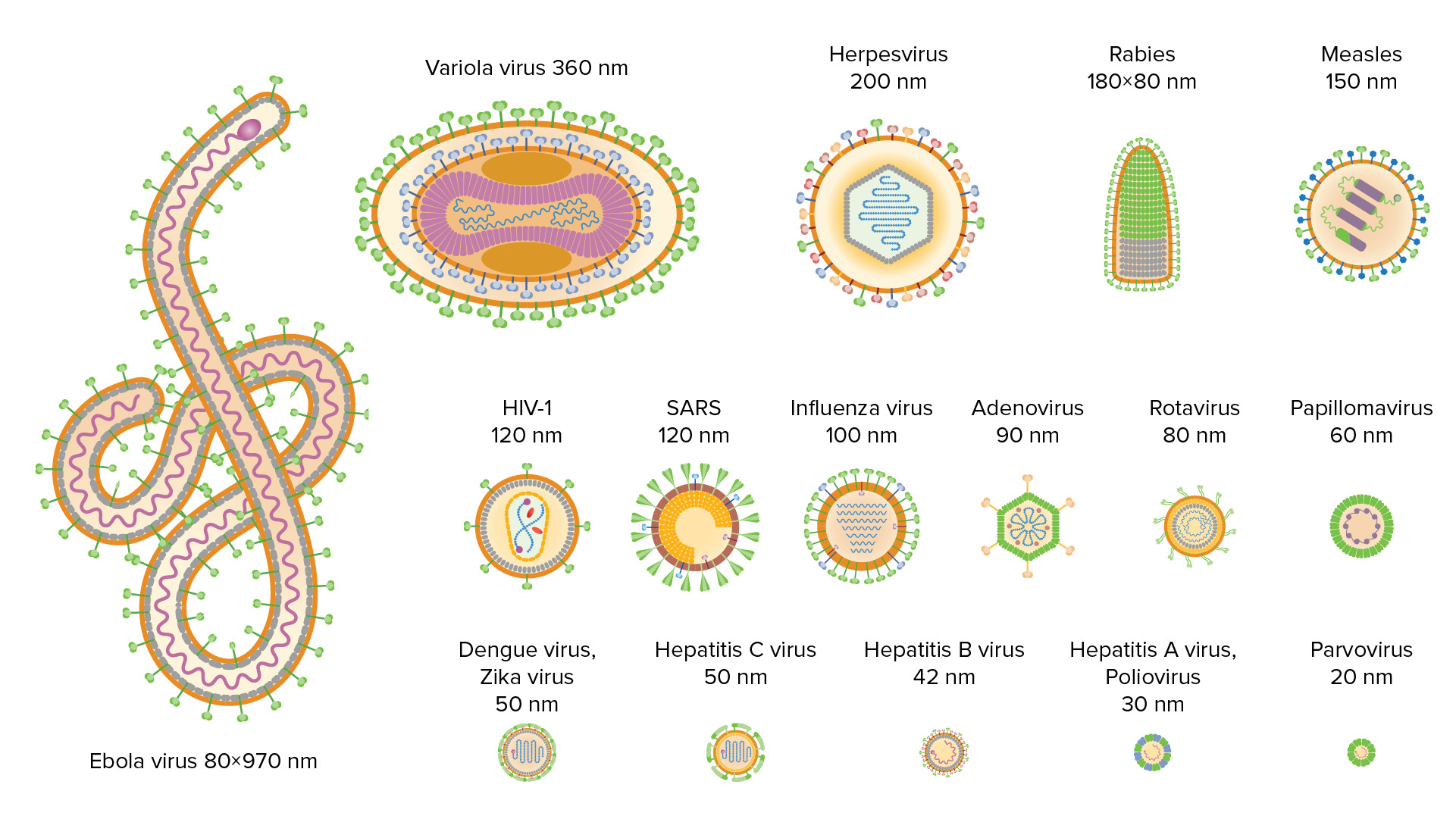Playlist
Show Playlist
Hide Playlist
Viral Genomes
-
Slides 04 Viruses MicrobiologyAdvanced.pdf
-
Download Lecture Overview
00:01 Now perhaps you don't know some of the terminologies that I've been using so far in describing this Baltimore scheme, so some definitions are in order. A messenger RNA or mRNA which is ready to be translated, has been assigned the plus strand polarity. This has nothing to do with electric charge or anything else, it's just a convention, mRNA is called the plus strand, because it has many nucleic acids, there are two strands so we have to designate one or the other. DNA of the equivalent polarity as mRNA is also called the plus strand. Now DNA is not translated; this is just a convention to show that this strand of DNA is the same polarity as mRNA. Both RNA and DNA compliments of plus strands are called minus or negative strands and finally remember, not all plus stranded RNA is mRNA. Just because an RNA has a positive polarity doesn't mean it's going to be translated. On the other hand if we call it mRNA, that means it will be translated. 01:06 Let's take a little bit of a look at the viral genome now we've spent some time talking about how it was discovered and how it can be categorized. What's encoded in a viral genome? Well we know that there are gene products and regulatory signals to replicate the genome viruses need to reproduce, so the genome has to be replicated. We know that there are signals for putting together the genome into a virus particle, we call that assembly and packaging. We know there are genes for regulating and timing the replication cycle. When a virus enters a cell, not everything happens at once, it would not make sense for example, to produce structural proteins until they are needed for assembly of new virus particles, so that timing is encoded in the genome. Many viruses encode at least one protein that modulates host defenses. If they don't, they would no longer exist on the planet. And finally there are genes encoding proteins that are needed to spread from that first cell that's infected to other cells or other hosts. And these are just some of the gene products encoded in a genome. 02:13 We do know what is not encoded in a genome, there are no genes encoding a complete protein synthesis machinery. That's why viral mRNA has to be ready for host cell translation. 02:27 Some viral genomes do contain genes that encode components of the translation system, like aminoacyl trna synthetases, initiation factors and even transfer RNAs, but no virus encodes the complete translation system. There are no genes encoding proteins involved in energy production or membrane biosynthesis, again those have to come from the cell. And there are no classical centromeres or telemerers that you would find in a standard host chromosome. 02:57 The absence of such genes, as well as many others, is why viruses are obligate intracellular parasites. Now it may be that we simply haven't discovered some of these genes. We discover viruses on a daily basis, hundreds and hundreds every day, and over half of the genes that are in these new viruses we've never seen before, so it could be that some of the functions that we just said are not in genomes will eventually be found to be there as well.
About the Lecture
The lecture Viral Genomes by Vincent Racaniello, PhD is from the course Viruses.
Included Quiz Questions
Which part of a bacteriophage is injected into the host bacterial cell?
- DNA
- mRNA
- Protein precursors
- Virus
- Viral envelope
What information may be encoded in a viral genome?
- Enzymes to replicate the viral genome
- Gene products that catalyze membrane biosynthesis
- Centromeres or telomeres
- Complete protein synthesis systems
- Gene products that catalyze energy production
How does hemagglutination measures viral particles?
- By measuring particles attached to RBCs
- By measuring particles attached to WBCs
- By measuring viral particle load
- By electron microscopy
- By assaying viral enzyme activity
What is the first crucial step in viral replication?
- The viral genome must be converted into mRNA.
- Viral DNA must be replicated in the cytoplasm.
- Host ribosomes must form into 30S and 50S subunits.
- Proteins from the virus must interact with the host DNA.
- Host DNA must be spliced with viral DNA.
Based on the mRNA theory, how many types of viral genomes exist?
- 7
- 357
- 37
- 37 x 10
- 3
Which of the following statements regarding mRNA is true?
- mRNA is always (+) sense.
- mRNA is always (-) sense.
- mRNA is always a neutral polarity.
- mRNA is always composed of DNA.
- mRNA is always reciprocal to the polarity of DNA.
Most viral genomes lack which of the following?
- Genes encoding for complete protein synthesis machinery
- Proteins necessary for infection of host cells
- Genes necessary for regulation of the cell cycle
- Viral products necessary for genome replication
Which among the following is the largest virus?
- Pandoravirus
- Mimivirus
- Parvovirus
- Poxvirus
- Hepatitis B virus
In RNA and DNA, what is the name of the strand complementary to the plus strand?
- The minus strand
- The sense strand
- The positive strand
- The coding strand
- The non-template strand
Which of the following genes are absent in viruses?
- Genes for energy production
- Genes for enzymes
- Genes for structure proteins
- Genes for nucleocapsid core proteins
- Genes for pol proteins
Customer reviews
5,0 of 5 stars
| 5 Stars |
|
1 |
| 4 Stars |
|
0 |
| 3 Stars |
|
0 |
| 2 Stars |
|
0 |
| 1 Star |
|
0 |
Simple and easy to understand, he really likes the subject. I wish the videos were longer with more information. Maybe an advance lecture? Thank you!




